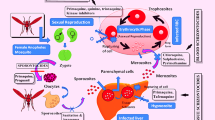Abstract
From the n-hexane, ethyl acetate and methanol extracts of Toddalia asiatica root bark were isolated eight compounds (1–8) which were identified on the basis of both spectroscopic and physical data as well as comparison with already published results. The crude extracts and isolated compounds showed moderate in vitro antiplasmodial activity against D6 (chloroquine-sensitive) and W2 (chloroquine-resistant) strains of Plasmodium falciparum. The extracts and isolates also exhibited larvicidal activities against Aedes aegypti and coumarins were identified as the active compounds.

Chemical examination of Toddalia asiatica root bark resulted into the isolation of eight compounds which were evaluated for antiplasmodial and larvicidal activities. Toddaculatin (3) was the most active against chloroquine sensitive D6 strain of Plasmodium falciparum while toddanol (6) was found to be toxic against Aedes aegyti 2nd instar larvae.
Similar content being viewed by others
References
Usher G 1974 A dictionary of plant used by man (London: Constable LTD) p. 113
Kokwaro J O 1976 Medicinal plants of East Africa (Nairobi: Kenya Literature Bureau) p. 123
Muregi F W, Ishih A, Miyose T, Suzuki T, Kino H, Amano T, Mkoji G M and Terada M 2007 J. Ethnopharmacol. 111 190
Muregi F W, Ishih A, Miyose T, Suzuki T, Kino H, Amano T, Mkoji G M and Terada M 2007 Phytother. Res. 21 337
Buckingham J 1994 Dictionary of natural products (London: Chapman and Hall) Vol. 7, p. 78
Chen Y C, Tsai W J, Wu M H, Lin L C and Kuo Y C 2007 Br. J. Pharmacol. 150 298
Oketch-Rabah H A, Mwangi J W, Listergen J and Mberu F K 2000 Fitoterapia 71 636
Heather E K, Suryanarayana V V, Matthew F S, Melissa J R and John D 2002 J. Carcinog. 23 1667
Gakunju D M N, Mberu E K, Dossaji S F, Gray A I, Waigh R D, Waterman P G and Watkins W M 1995 Antimicrob. Agents Chemother. 39 2606
Lakshmi V, Kapoor S, Pandey K and Patnaik G K 2002 Phytother. Res. 16 281
Rashid M A, Gustafson K R, Kashman Y, Cardellina J H, McMahon J B and Boyd M R 1995 Nat. Prod. Lett. 6 153
Ishii H, Kobayashi J, Ishikawa T, Haginiwa J and Ishikawa T 1991 Yakugaku Zasshi 111 365
Ping H, Karagianis G, Wei-Shan X and Waterman P 2005 Nat. Prod. Res. Dev. 17 82
WHO 1981 Instructions for determining the susceptibility or resistance of mosquito larvae to insecticides, WHO/VBC/81 pp. 807
WHO 2005 Guidelines for laboratory and field testing of mosquito larvicides, WHO/CDS/WHOPES/GCDPP/2005
Trager W and Jensen J B 1976 Science 673
Iwasaki H, Oku H, Takara R, Miyahira H, Hanashiro K, Yoshida Y, Kamada Y, Toyokawa T, Takara K and Inakuju M 2006 Cancer Chemother. Pharmacol. 8 1
Ishii H, Kobayashi J, Sakurada E and Ishikawa T 1992 J. Chem. Soc. 1 1681
Gopalakrishna E M, Bittner M, Silva W H and Watson W H 1977 J. Cryst. Mol. Struct. 7 107
Furukawa H, Ito C and Mizuno T 1990 J. Chem. Soc. 1 1593
Tsai Wu M F, Teng C M, Ishikawa T and Chen S 1998 Phytochemistry 48 1377
Ochieng C 2008 Evaluation of bioactive constituents of Gardenia Ternifolia and metabolites of the bark of Millettia for malaria control principles. MSc Thesis, Maseno University p. 250
Bray D H, Warhurst D C, Connoll J D, O’Neill M J and Phillipson J D 1990 Phytother. Res. 4 29
Acknowledgements
We acknowledge support from the Inter University Council for Eastern Africa (IUCEA) through VicRes for funding the project. Mr. S G Mathenge is thanked for the identification of the plant material. Prof. Lutz Tietze of Georg-August University Goettingen is also thanked for providing both NMR and MS analysis.
Author information
Authors and Affiliations
Corresponding authors
Rights and permissions
About this article
Cite this article
NYAHANGA, T., JONDIKO, J.I., MANGURO, L.O.A. et al. Antiplasmodial and larvicidal compounds of Toddalia asiatica root bark. J Chem Sci 125, 1115–1121 (2013). https://doi.org/10.1007/s12039-013-0483-x
Received:
Revised:
Accepted:
Published:
Issue Date:
DOI: https://doi.org/10.1007/s12039-013-0483-x




